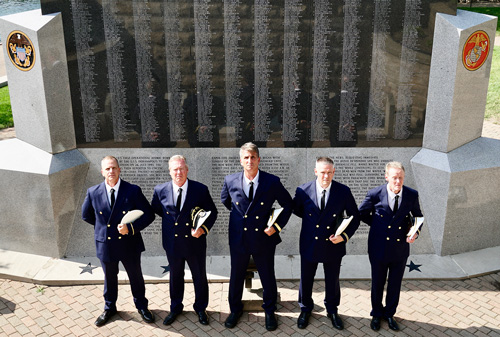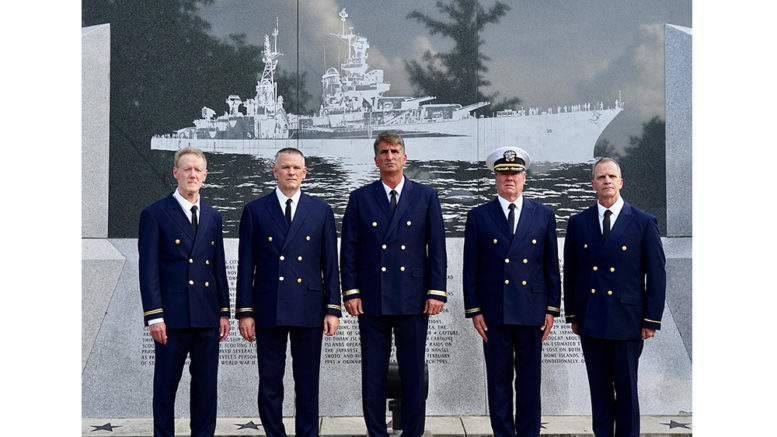‘Failure to Zig Zag’ starts Friday at the Cat in Carmel
On July 30, 1945, the USS Indianapolis was returning from a secret mission when it was torpedoed by the Imperial Japanese Navy submarine I-58 and sank in 12 minutes. Only 317 of the 1,195 men onboard survived.
Neither the captain of the USS Indianapolis, Charles McVay III, nor his crew were told the cargo they had just delivered to the island Tinian contained the essential components for the atomic bomb to be dropped in Hiroshima. The crew languished in shark-infested waters while Naval authorities logged the ship safe in port. The navy’s cover-up and attempt to make Capt. McVay a scapegoat led to a national scandal.
Never before in military history had a captain been put on trial because his ship was sunk by the enemy.
Starting Friday, July 19, as the survivors and their families gather in downtown Indianapolis for their annual reunion, the Carmel Community Players (CCP) will stage “Failure to Zig Zag: The Story of the USS Indianapolis” at the Cat, 254 Veterans Way, Carmel.
According to director Susan Rardin, “Failure to Zig Zag” received its professional premiere at the Indiana Repertory Theatre in 1981 and has not been staged in Indiana since.
“A lot of younger men don’t even know about the Indy and secret mission and the importance of the ship,” Rardin told The Reporter.
On the Indianapolis’s return voyage when they were supposed to go to Leyte, they were sunk by the Japanese.
“The Indy actually got off three S.O.S. calls,” Rardin said. “They were all received. The Navy chose to not respond for various reasons. If they would have responded to any one of them, it would have changed the course of history. These men who delivered the parts of the bomb that would help end the war were not treated with the respect I think they deserved for that mission. They were marked as not important. The three S.O.S. calls were not responded to. Only by sheer luck did someone fly over and see the men in the water, then proceed to call it in and rescue these gentlemen.”
Many know of the USS Indianapolis from the monologue by Robert Shaw’s character, Quint, in the 1975 movie “Jaws.” That limited view of the Indianapolis is one reason Rardin wanted to stage this play.
“That’s one of the things that is concerning to me – I don’t want people to think of the Indianapolis only as the men in the water with the sharks because it is so much more than that,” Rardin said. “These are heroes who changed the course of history. [The shark attacks] are addressed in this show and it is a very respectful. What we are doing with those scenes, because we are in a much smaller venue, I think is a much stronger scene.”

Photo provided by Carmel Community Players
Captain McVay
Retired Hamilton Southeastern teacher Tim Latimer plays the role of Capt. McVay. This is his third play with CCP.
“When I saw this on CCP’s website in March I ordered the script,” Latimer told The Reporter. “I was convinced I wanted to play the prosecutor’s role. I thought, ‘That’s a worthy admiral.’ Both of those guys are kind of jerks and I have had a couple plays where I got to play the bad guy and I kind of like that. When I came to auditions I fully expected to be the prosecutor, but they asked me to read a lot of McVay.”
Latimer says he hopes he can portray Capt. McVay in a way that both McVay himself and the men who knew him would be proud of.
“I want to play the part in such a way that if Capt. McVay were alive, he’d approve,” Latimer said. “Capt. McVay’s crew loved him and many people felt a great empathy for him. I want people to see how he interacted with the men on his ship.”
The challenge of playing a historical character from relatively recent history is not lost on Latimer.
“There is a great deal of pressure to do it right,” Latimer said. “My biggest fear is for somebody to come up after the play and say, ‘Well Capt. McVay wasn’t like that at all.’ I don’t want that to happen and I don’t think it will. I hope that people will say I had a great portrayal of Capt. McVay. That’s what you want in community theater – for people to feel you did a good job.”
Commander Hashimoto
In his first appearance on stage, Ron Gotanco plays the role of Japanese submarine commander Mochitsura Hashimoto.

Gotanco
Gotanco told The Reporter he has been interested in acting for a long time but has never stepped into the spotlight before.
“I did a lot of coursework in high school and college,” Gotanco said. “I did not have the free time to do anything and I wasn’t going to make a career out of it, so 25 years later here I am.”
For his first role, Gotanco has jumped right into the deep end.
“It is a very intense character,” Gotanco said. “This is five months after the sinking of the Indianapolis and the end of World War II. I am playing the enemy. My character was involved in the Pearl Harbor attack. I play the one who sunk the Indianapolis. The men who survived look at me as the cause of a lot of their misery and suffering. I am in a courtroom full of hostility and foreigners. You will see a transformation. It is an unlikely comrade that I find in Capt. McVay.”
Gotanco draws on his own life as well as a great deal of research in his work to portray Hashimoto.
“It is easy to start with the obvious: The physical differences,” Gotanco said. “Even though I was born here in the United States, I physically look different than everyone else in the play. You can start there. The next step I took was to do as much research as I could about him.”
According to Gotanco, his character was the eighth child in his family. His father was a Shinto priest who wanted him to go to the naval academy to try to better his status and position.
 “From what I can read he was quite a patriotic person,” Gotanco said. “Later he became more of a passivist. He eventually became a Shinto priest like his father. It is well known that he was a one of the people who lobbied Congress and the Navy to exonerate McVay.”
“From what I can read he was quite a patriotic person,” Gotanco said. “Later he became more of a passivist. He eventually became a Shinto priest like his father. It is well known that he was a one of the people who lobbied Congress and the Navy to exonerate McVay.”
Capt. McVay was finally exonerated Oct. 30, 2000, five days after Hashimoto passed away.
“The difficulty is going through that transformation of being in a hostile environment, finding someone you relate to, who turns out be the person who should have the most hostility against you, develop this respect for him, and in the end develop what sounds like a lifelong tie – something that connects the two of them,” Gotanco said.
The USS Indianapolis sank on July 30, 1945. Wreckage of the ship was finally located on Aug. 19, 2017, in the Philippine Sea at a depth of 18,044 feet.
CCP was invited by Marie Beason from the Indiana War Memorials organization to perform scenes at the USS Indianapolis Survivors Luncheon on Friday, July 19. Hours later they will take the stage for opening night at the Cat.
Knowing a USS Indianapolis survivor
Kevin Caraher plays defense attorney James Harcourt in the Carmel Community Players production of “Failure to Zig Zag.” He was interested in the role and in the history of the ship because of a personal connection with a man who served aboard her.

Caraher
“My family was good friends with the family of USS Indianapolis survivor James O’Donnell,” Caraher told The Reporter. “We lived just up the street from them in the Irvington area on the east side. We grew up with his four children in grade school and used to play together a lot. We knew the family really well. That is one of the reasons I wanted to do this show. I have always had an interest in the Indianapolis.”
While Caraher knew O’Donnell, they never spoke about O’Donnell’s experience on the Indianapolis.
“I always figured that was a topic that was off limits,” Caraher said. “He was a very quiet man. He was very well respected. When they had the visitation at his funeral several years ago at Holy Spirit out on the eastside, they had to use the gymnasium because of the hundreds of people that came.”
Caraher said he learned more about O’Donnell’s life and experiences after he passed away.
“Everything I would know about his story onboard the Indianapolis would come from his chapter in the book ‘Only 317 Survived,’ which is a compilation of survivors’ stories,” Caraher said. “He always had a booth at Irish Fest with some of his buddies pushing that book. Proceeds went to the Indianapolis Monument. I have a copy with a few of the other survivors’ signatures in there as well.”
There is a statue of O’Donnell that the city dedicated outside of the City Market in downtown Indianapolis.
Caraher said playing this role has taught him a great deal about the Indianapolis and about naval history.
“What I was surprised at was naval procedures back then,” Caraher said. “I was surprised that during the war they had procedures in place that didn’t seem to make sense at all. Number one, which we touch on in the script, is that is a ship was overdue in port there was no procedure for reporting its non-arrival. They just erased it off the board. That is astounding to me.”
The radio officer in the Indianapolis was able to send multiple distress calls and they were received, but nothing was done about them.
“The Army pilot who flew over saw distress flares and reported it, but nothing was done about it,” Caraher said. “Those things are just mind-boggling. The Army reported it to their own superior officers. During that time the Army and the Navy didn’t communicate very well with one another, which is amazing. Needless to say, those procedures did change after the war.”
“Failure to Zig Zag” stages from July 19 to 28 at the Cat, 254 Veterans Way, Carmel.

